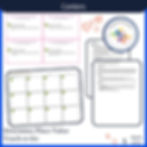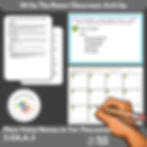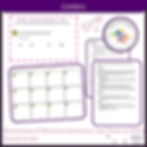
Writing the Present Levels of Performance (PLOP) in an Individualized Education Program (IEP) is a critical task for special education teachers. This section provides a detailed picture of a student’s current abilities, challenges, and needs, setting the stage for measurable and meaningful IEP goals. But let’s be honest—writing a clear, comprehensive PLOP can be time-consuming. That’s where artificial intelligence (AI) tools can help!
In this article, we’ll explore how to use AI to draft PLOPs, the pros and cons of this approach, and tips to ensure the final product meets your students’ needs. Whether you're new to AI or just curious about how it can streamline your work, this guide has you covered.
What Are Present Levels of Performance (PLOP)?
The PLOP is the foundation of every IEP. It outlines:
Academic Performance: Reading, writing, math, etc.
Functional Performance: Social-emotional skills, behavior, self-regulation.
Strengths and Challenges: What the student excels at and where they need support.
Assessment Data: Standardized test scores, progress monitoring, and observational data.
The PLOP should provide a clear snapshot of where the student is today, allowing the IEP team to create SMART (Specific, Measurable, Achievable, Relevant, and Time-bound) goals.
How to Use AI to Write PLOP Statements
Using AI to write PLOP statements can be a game-changer for busy special education teachers. Here’s a step-by-step guide:
Gather Your DataCollect information about the student’s performance, including:
Test scores
Observations
Parent and teacher input
Work samples
Behavioral data
Organize Information Divide the data into categories like academics, behavior, and functional skills. Identify the student’s strengths and challenges in each area.
Input Data into AI Use an AI tool to draft the PLOP. Provide specific details about the student’s abilities and needs. For example:
Mathew is a 7th-grade student who reads fluently at grade level but struggles with reading comprehension. He scored 40% on the Reading Comprehension Benchmark and requires 3-4 prompts to initiate independent work.
Review and Edit AI is great for generating drafts, but you’ll need to review the text to ensure it’s accurate, specific, and reflects the student’s unique needs. Add any personal observations or insights to make the PLOP more tailored.
Finalize and Share After editing, incorporate the PLOP into the IEP and share it with the team.
Pros and Cons of Using AI for PLOPs
Pros
Saves Time: AI can draft a PLOP in minutes, giving you more time to focus on other tasks.
Consistency: AI ensures your writing is clear and professional.
Idea Generation: Struggling to find the right words? AI can help you get started.
Customizable: You can easily tweak the AI-generated content to fit your student’s needs.
Cons
Lacks Personal Insight: AI doesn’t know your student like you do, so the draft may feel generic.
Data Input Required: You still need to provide accurate and detailed information for AI to work effectively.
Potential for Errors: AI might misinterpret your input or produce text that needs significant revision.
Not a Replacement for Expertise: AI can assist but shouldn’t replace your professional judgment.
Tips for Success
Be Specific in Your Input The more detailed your input, the better the output. Include assessment data, examples of behaviors, and specific observations.
Use AI as a Starting Point Think of AI as your assistant. Use it to generate drafts, but always review and refine the content.
Keep It Student-Centered Make sure the final PLOP reflects the student’s unique strengths and needs, not just generic phrases.
Balance Efficiency with Accuracy While AI speeds up the process, take the time to ensure the PLOP aligns with legal requirements and best practices.
Overcoming the Cons of Using AI for PLOPs
While AI offers many benefits, addressing its potential drawbacks ensures that the final product meets your students’ unique needs. Here are practical strategies for overcoming the cons of using AI for PLOPs:
1. Add Personal Insights to Avoid Generic Statements
AI drafts can feel impersonal because they lack your knowledge of the student. To counter this:
Include specific examples of the student’s behaviors, strengths, and challenges that only you can observe.
Use anecdotes or classroom scenarios to make the PLOP more relatable and detailed.
Example: If the AI writes, “Mathew struggles with task initiation,” you could enhance it by adding, “Mathew requires 3-4 verbal prompts to start independent tasks but demonstrates improved focus when given a visual checklist.”
2. Ensure Accurate Data Input
AI is only as good as the information it receives. Here’s how to make your input more precise:
Use detailed and organized data, such as test scores, progress monitoring notes, and observations.
Double-check that your input accurately reflects the student’s performance.
Tip: Create a checklist of data points to include before using AI, ensuring no critical information is left out.
3. Validate and Revise AI-Generated Text
To prevent errors or inaccuracies:
Review the AI draft carefully, checking for misinterpretations or missing details.
Revise language to align with legal requirements and your district’s standards.
Example: If AI writes, “Student exhibits difficulty with reading comprehension,” you might revise it to: “Mathew scored 40% on the Reading Comprehension Benchmark and struggles with identifying main ideas and making inferences in grade-level texts.”
4. Balance AI with Professional Judgment
AI can’t replace your expertise as a special education teacher. Use it to save time, but trust your instincts:
Add your observations about how the student’s challenges impact their learning.
Adjust the tone and content to ensure the PLOP feels authentic and individualized.
5. Use AI to Complement Collaboration
Collaborate with other IEP team members to refine the AI-generated draft. Teachers, parents, and related service providers can offer additional insights to enhance the PLOP.
Tip: Share the draft with your team and ask for feedback to ensure a well-rounded perspective.
Final Thoughts

AI tools can be incredibly helpful for drafting PLOPs, but they’re not a one-size-fits-all solution. As special education teachers, our expertise, knowledge of our students, and personal insights are irreplaceable. By addressing the challenges of using AI proactively, we can streamline the PLOP-writing process without compromising quality. The key is blending technology with your professional judgment to create IEPs that truly support student success.
Pro Tip from Our Readers: One reader shared that they upload PDFs of district STAR Testing reports, SBA scores, and IXL progress reports to provide up-to-date, skill-by-skill PLOPs in both ELA and math. Additionally, student report cards in PDF form are a great resource for summarizing academic performance. Uploading teacher notes and comments from emails adds a personal, individualized tone to the PLOP report. These combined sources make the PLOP more comprehensive and specific to the student’s needs.
This approach balances efficiency with accuracy and empowers teachers to use technology as a tool—not a crutch. Have you tried using AI to write PLOPs? Share your experiences, tips, or concerns in the comments below! Let’s collaborate to make IEP writing a little less daunting for everyone.
































